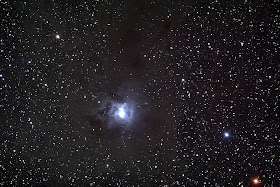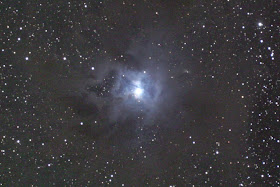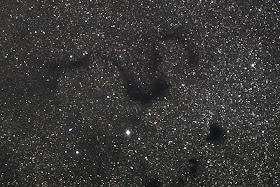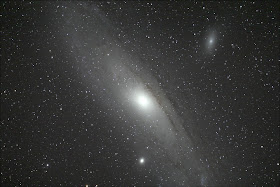What needs doing? Well with electronic sensors, for every exposure, say 4 minutes, there is noise that builds up on the detector, even if the shutter wasn't open. This "dark current" needs to be measured for every pixel on the detector (easier than it sounds). My Canon camera has a "noise correction" feature that takes a "dark" after the object exposure and subtracts it in-camera. Also, no matter how perfect your optics, the light will fall off in the corners of the frame, and this "flat fielding" needs to be done to all the exposures - I use short exposures of the twilight sky to correct for illumination. And generally the last thing I do is stack exposures - noise and bright objects in the field of view limit the exposure to a few minutes, but if you take multiple exposures, you can stack them to reduce the noise and get the effect of a single longer exposure. A little fine-tuning of the brightness and contrast in photoshop "stretches" out the detail so it can be seen.
These exposures are all from 3/4 September, 2007 when I went out near the base of Kitt Peak to take some images with my Celestron 14", Hyperstar and Canon 20Da. The Hyperstar optical system allows the sizeable telescope to take in a relatively wide-angle view of the sky a couple degrees across, yet with a F/ratio of 1.9, makes for some short exposures - that's a good thing! Short exposures reduce the number of trailed images caused by mount tracking errors.
 My first object was called NGC 7023 - the Iris nebula. I had never looked for it before, but had seen some stunning images of it. I was surprised to find how bright it was - seems to me I should have seen this before in some of our dark-sky observing sessions. The brief exposures show how the inner part of the nebula could remind one of its namesake flower. More interestingly (to me, anyway), was the dark nebula extending upwards.
My first object was called NGC 7023 - the Iris nebula. I had never looked for it before, but had seen some stunning images of it. I was surprised to find how bright it was - seems to me I should have seen this before in some of our dark-sky observing sessions. The brief exposures show how the inner part of the nebula could remind one of its namesake flower. More interestingly (to me, anyway), was the dark nebula extending upwards.  It reminded me very much of the recently posted shot of the cocoon nebula (click here ) . I suspect the 2 objects, composed of gas and dust, are indeed very similar, with the massive bright blue star providing the basic color of the Iris Nebula being the main difference). Note in the wider field, there is an abundance of dark, obscuring clouds throughout the image - needs more exposure to allow more stretching of the details!
It reminded me very much of the recently posted shot of the cocoon nebula (click here ) . I suspect the 2 objects, composed of gas and dust, are indeed very similar, with the massive bright blue star providing the basic color of the Iris Nebula being the main difference). Note in the wider field, there is an abundance of dark, obscuring clouds throughout the image - needs more exposure to allow more stretching of the details!  Also that night, I took a series of exposures of a dark nebula in the constellation Ophiuchus. Called B72, it's nickname is the Snake Nebula. Very difficult to see visually, it is relatively easy to photograph. These dark, dust clouds are only visible because they block the light from the more distant star clouds of our galaxy.
Also that night, I took a series of exposures of a dark nebula in the constellation Ophiuchus. Called B72, it's nickname is the Snake Nebula. Very difficult to see visually, it is relatively easy to photograph. These dark, dust clouds are only visible because they block the light from the more distant star clouds of our galaxy.I also got the chance to do a few "snapshots", just to see how an object will look with the setup I'm using. Usually I don't bother to find guide stars for tracking, just hope the mount will do ok for a 60 second exposure or so... I grabbed 2-60 second exposures of the nearby bright galaxy M32, and also the Helix Nebula.  M32, also called the Andromeda galaxy, is a big bright galaxy a mere 2.2 million light years away. It is also the farthest you can see with your naked eye if you get to a dark sky! In the photo you can spot the two small companion galaxies it sports, just like our own Milky Way Galaxy with the 2 Magellanic Clouds. The Andromeda Galaxy is bigger than our own, but similarly has a spiral structure, and contains clouds of dust and stars in it's makeup.
M32, also called the Andromeda galaxy, is a big bright galaxy a mere 2.2 million light years away. It is also the farthest you can see with your naked eye if you get to a dark sky! In the photo you can spot the two small companion galaxies it sports, just like our own Milky Way Galaxy with the 2 Magellanic Clouds. The Andromeda Galaxy is bigger than our own, but similarly has a spiral structure, and contains clouds of dust and stars in it's makeup.  The Helix Nebula is a nearby "planetary" nebula - so called because early discoveries of these resembled the blue-green disks of the outer planets Uranus and Neptune. These objects result from an evolved star - as it runs out of hydrogen fuel, it blows off part of it's mass into a shell of gas as the remnant star collapses into a white dwarf (still visible in the center...). Eventually I hope to get back to these objects to collect more data for better exposures... And working with the computerized images will have to do until getting back to those Arizona skies in a couple months!
The Helix Nebula is a nearby "planetary" nebula - so called because early discoveries of these resembled the blue-green disks of the outer planets Uranus and Neptune. These objects result from an evolved star - as it runs out of hydrogen fuel, it blows off part of it's mass into a shell of gas as the remnant star collapses into a white dwarf (still visible in the center...). Eventually I hope to get back to these objects to collect more data for better exposures... And working with the computerized images will have to do until getting back to those Arizona skies in a couple months!
 M32, also called the Andromeda galaxy, is a big bright galaxy a mere 2.2 million light years away. It is also the farthest you can see with your naked eye if you get to a dark sky! In the photo you can spot the two small companion galaxies it sports, just like our own Milky Way Galaxy with the 2 Magellanic Clouds. The Andromeda Galaxy is bigger than our own, but similarly has a spiral structure, and contains clouds of dust and stars in it's makeup.
M32, also called the Andromeda galaxy, is a big bright galaxy a mere 2.2 million light years away. It is also the farthest you can see with your naked eye if you get to a dark sky! In the photo you can spot the two small companion galaxies it sports, just like our own Milky Way Galaxy with the 2 Magellanic Clouds. The Andromeda Galaxy is bigger than our own, but similarly has a spiral structure, and contains clouds of dust and stars in it's makeup.  The Helix Nebula is a nearby "planetary" nebula - so called because early discoveries of these resembled the blue-green disks of the outer planets Uranus and Neptune. These objects result from an evolved star - as it runs out of hydrogen fuel, it blows off part of it's mass into a shell of gas as the remnant star collapses into a white dwarf (still visible in the center...). Eventually I hope to get back to these objects to collect more data for better exposures... And working with the computerized images will have to do until getting back to those Arizona skies in a couple months!
The Helix Nebula is a nearby "planetary" nebula - so called because early discoveries of these resembled the blue-green disks of the outer planets Uranus and Neptune. These objects result from an evolved star - as it runs out of hydrogen fuel, it blows off part of it's mass into a shell of gas as the remnant star collapses into a white dwarf (still visible in the center...). Eventually I hope to get back to these objects to collect more data for better exposures... And working with the computerized images will have to do until getting back to those Arizona skies in a couple months!
WOW! Spectacular shots Dean! Gotta love those fast "lenses" eh! :-)
ReplyDeleteKeep'em comin'.
Dave